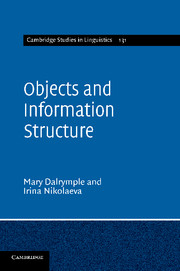Book contents
- Frontmatter
- Contents
- Preface and Acknowledgements
- List of Abbreviations
- 1 Introduction
- 2 Syntactic assumptions
- 3 Information structure in grammar
- 4 Syntax and information structure
- 5 Topicality and grammatical marking
- 6 Topical marking of nonsubjects
- 7 Topicality and DOM
- 8 Primary and secondary objecthood and DOM
- 9 Multiple objects and grammatical alignment
- 10 Semantic features, topicality and grammaticalisation
- 11 Conclusion
- References
- Author Index
- Language Index
- Subject Index
10 - Semantic features, topicality and grammaticalisation
Published online by Cambridge University Press: 05 October 2012
- Frontmatter
- Contents
- Preface and Acknowledgements
- List of Abbreviations
- 1 Introduction
- 2 Syntactic assumptions
- 3 Information structure in grammar
- 4 Syntax and information structure
- 5 Topicality and grammatical marking
- 6 Topical marking of nonsubjects
- 7 Topicality and DOM
- 8 Primary and secondary objecthood and DOM
- 9 Multiple objects and grammatical alignment
- 10 Semantic features, topicality and grammaticalisation
- 11 Conclusion
- References
- Author Index
- Language Index
- Subject Index
Summary
As discussed in Chapter 1, most previous work on DOM is based on semantic features such as person, animacy, definiteness and specificity (Diesing 1992, van Geenhoven 1998, Ritter and Rosen 2001, Aissen 2003b). However, we have seen that these features are not enough to explain object marking patterns in many languages, and we have argued that in many cases the appropriate generalisations involve the notion of topicality, especially secondary topicality. The topicality of a referent depends on how the speaker construes the situation within the given communicative context; features of topic-worthiness determine only the likelihood for the object to be construed as topical.
What our account must still explain is why DOM in some languages does in fact depend on semantic features rather than the information-structural notion of topicality, sometimes in combination with information structure and sometimes independent of it. In this chapter we propose a historical explanation for these patterns, based on the notion of grammaticalisation. We suggest that in many languages semantic patterns of DOM arise as a result of different stages and directions of grammaticalisation of topical marking on objects.
Case studies
We sketch the historical evidence for the emergence of DOM in Uralic, Persian and Hindi. Presenting a fuller diachronic picture will of course require a much more detailed investigation; we view this chapter as the first step in this direction.
- Type
- Chapter
- Information
- Objects and Information Structure , pp. 194 - 218Publisher: Cambridge University PressPrint publication year: 2011



